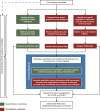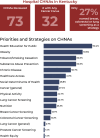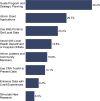A framework and process for community-engaged, mixed-methods cancer needs assessments
- PMID: 38809305
- PMCID: PMC11461567
- DOI: 10.1007/s10552-024-01892-2
A framework and process for community-engaged, mixed-methods cancer needs assessments
Abstract
Purpose: Community health needs assessments are required for most state and local public health agencies and non-profit hospitals. Typically based on community health improvement planning models, these assessments encompass overall community health and multiple diseases to inform program planning. National Cancer Institute (NCI)-designated Cancer Centers and community-based cancer-focused programs share the goal of reducing cancer burden in the catchment areas they serve. However, to date, no published models exist to guide cancer-specific needs assessments for a determined geographic area that can inform both public health and research initiatives. The purpose of this article is to outline a cancer needs assessment (CNA) framework and community-engaged, mixed-methods process, along with a case study of how we applied it in Kentucky.
Methods: We convened a steering committee of key organizational partners to provide input throughout the process. We developed a conceptual framework of multi-level determinants affecting cancer-related outcomes. We incorporated both quantitative and qualitative data gathered through a variety of means, including a novel application of group concept mapping to guide definition of priorities.
Results: The resulting CNA has helped guide strategic planning and priorities for Kentucky's Cancer Action Plan, Markey Cancer Center, state agencies, and community-based organizations.
Conclusion: This framework and process can be used collaboratively by cancer center Community Outreach and Engagement offices, public health agencies, oncology programs, and community partners to plan impactful cancer control programs and research in their catchment areas. Universities can also use them to inform the planning of community engagement and health equity research efforts.
Keywords: Catchment area; Community outreach; Needs assessment; Qualitative research; Quantitative evaluation.
© 2024. The Author(s).
Conflict of interest statement
The authors have no relevant financial or non-financial interests to disclose.
Figures





References
-
- Altschuld JW, Watkins R (2014) A primer on needs assessment: more than 40 years of research and practice: a primer on needs assessment: more than 40 years of research and practice. New Dir Eval 2014:5–18. 10.1002/ev.20099
-
- Public Health Accreditation Board Standards & Measures for Initial Accreditation, Version 2022
-
- Community Health Needs Assessment for Charitable Hospital Organizations—Section 501(r)(3). https://www.irs.gov/charities-non-profits/community-health-needs-assessm...
-
- Commission on Cancer, American College of Surgeons. Cancer Programs Standards 2012: Ensuring Patient-Centered Care. Version 1.2.1. https://apos-society.org/wp-content/uploads/2016/06/CoCStandards-1.pdf. Published 2012. Accessed 14 Sep 2023.
-
- The GW Cancer Center. Implementing the Commission on Cancer Standard 8: Addressing Barriers to Care. https://cancercontroltap.smhs.gwu.edu/sites/g/files/zaskib661/files/2021.... Published 2021. Accessed 12 Sep 2023.
MeSH terms
Grants and funding
LinkOut - more resources
Full Text Sources
Medical

